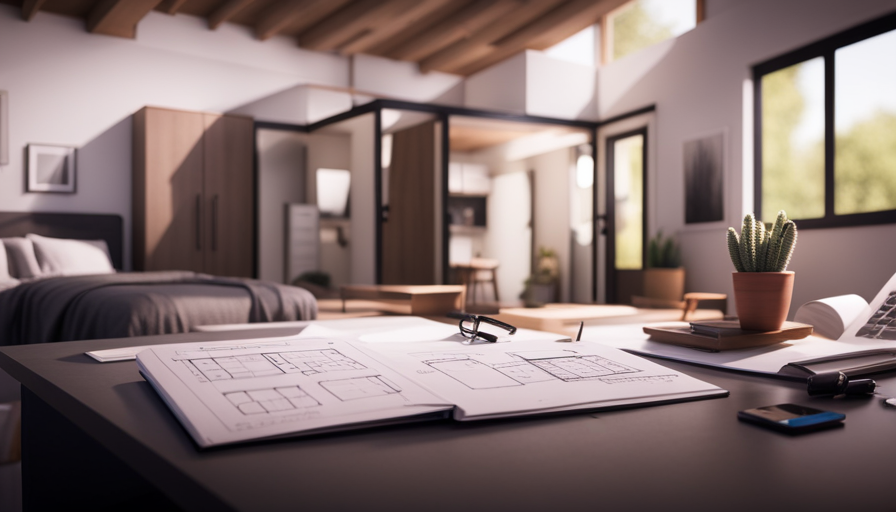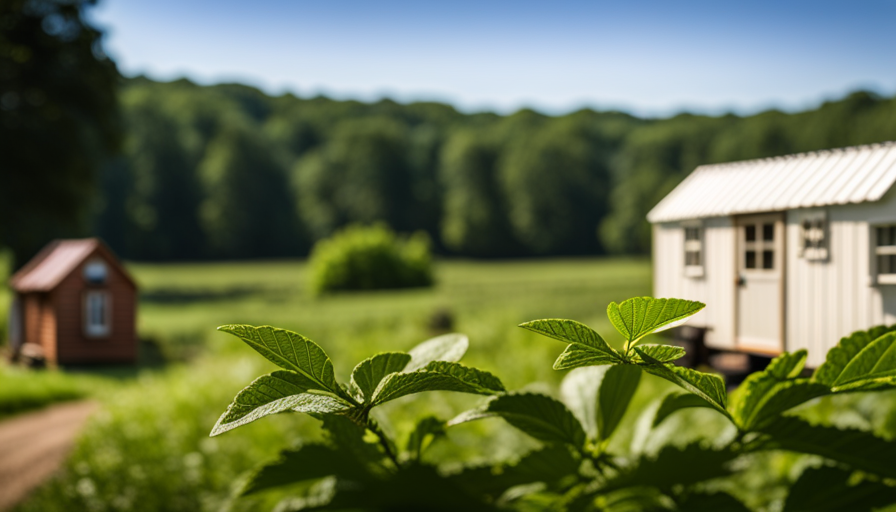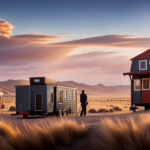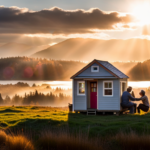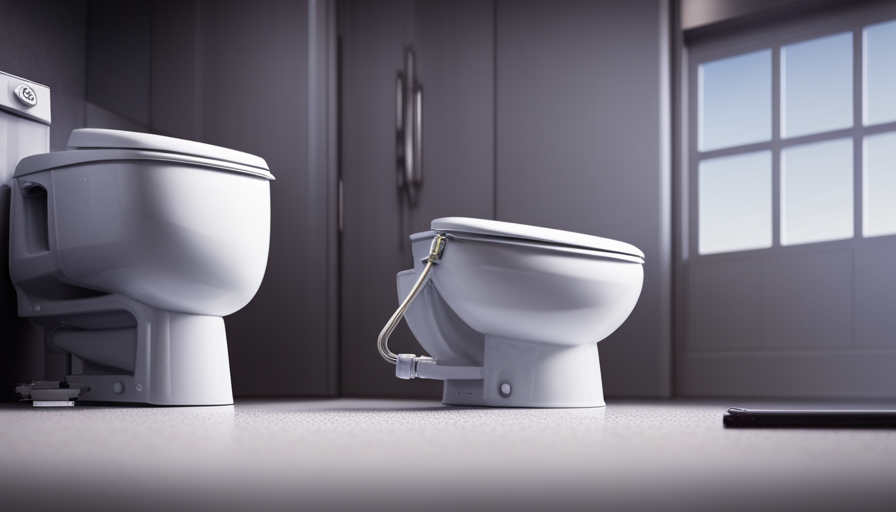Pleasantly, within the sphere of design, there is a collection of talented individuals who expertly design small living spaces, referred to as tiny houses. These creative minds, through their bold and unique methods, construct homes that are small yet charming.
In this article, we will explore the works of several talented individuals who have made their mark in the world of tiny house design.
Firstly, let us delve into the masterful mind of Jay Shafer, a pioneering figure in the tiny house movement. His meticulous attention to detail and ingenious utilization of space have revolutionized the way we perceive small living spaces.
Additionally, Dee Williams, an advocate for simpler and more sustainable living, has created awe-inspiring tiny houses that radiate charm and efficiency.
Moreover, we will discover the innovative work of Vina Lustado, whose designs seamlessly blend functionality and elegance.
Andrew Morrison’s expertise lies in crafting versatile and adaptable tiny homes, while Derek ‘Deek’ Diedricksen’s whimsical and imaginative creations showcase his boundless creativity.
Not to be overlooked are the works of Macy Miller, whose ingenious designs showcase the beauty of repurposed materials, and Kirsten Dirksen, a filmmaker who captures the essence of tiny house living through her insightful documentaries.
Join me as we embark on a journey into the world of these extraordinary designers, where every line, curve, and corner is meticulously crafted to create dreamlike dwellings that defy convention and inspire a more mindful way of living.
Key Takeaways
- Jay Shafer, Dee Williams, Vina Lustado, Andrew Morrison, Derek ‘Deek’ Diedricksen, Macy Miller, and Kirsten Dirksen are prominent designers in the tiny house movement.
- These designers prioritize maximizing space, minimizing waste, and incorporating innovative storage solutions in their tiny house designs.
- Sustainable building techniques, eco-friendly materials, and integration of nature are crucial elements in creating truly sustainable tiny houses.
- Andrew Morrison and Derek ‘Deek’ Diedricksen offer educational resources and workshops to empower others to design and build their own tiny houses.
Jay Shafer
Jay Shafer is often regarded as the pioneer of the tiny house movement. With his innovative designs and passion for minimalistic living, he’s inspired countless individuals to embrace a simpler way of life. Shafer’s expertise in design and construction has allowed him to create functional and aesthetically pleasing tiny homes that maximize space and minimize waste. His attention to detail is evident in every aspect of his designs, from the efficient use of storage solutions to the cleverly designed multi-purpose furniture. Shafer’s influence on the tiny house community is undeniable, as his designs have become a staple for those seeking a more sustainable and affordable lifestyle.
Transitioning into the next section about Dee Williams, it’s clear that her work has been heavily influenced by the pioneering designs of Jay Shafer.
Dee Williams
Dee Williams is a prominent figure in the tiny house movement, known for her advocacy of simple living. Her emphasis on efficiency and functionality in her designs is a testament to her commitment to creating practical and sustainable living spaces.
Williams’ expertise in maximizing limited space and creating multi-functional areas has inspired many others to embrace a minimalist lifestyle and rethink their own living arrangements.
Advocate for Simple Living
Imagine living a life free of clutter and excess, where every corner of your tiny house is designed to promote simplicity and tranquility. Embracing a minimalist lifestyle and downsizing has numerous benefits.
Firstly, it allows you to focus on what truly matters, stripping away the distractions of material possessions and creating space for personal growth and fulfillment. Secondly, downsizing promotes environmental sustainability by reducing waste and encouraging conscious consumption. It allows you to live more lightly on the earth, minimizing your carbon footprint and leaving a smaller impact on the planet.
As a designer who advocates for simple living, my goal is to create tiny houses that embody these principles, emphasizing efficiency and functionality. By carefully considering every aspect of the design, from the layout to the storage solutions, I strive to create spaces that maximize comfort and convenience while minimizing unnecessary clutter and stress.
Emphasis on Efficiency and Functionality
Embracing an emphasis on efficiency and functionality in your living space allows for a seamless integration of practicality and elegance.
When designing tiny houses, it becomes even more crucial to optimize every square inch. Efficiency in small spaces is key, as it allows for a comfortable and clutter-free environment. Designers who specialize in tiny houses understand this concept and utilize innovative solutions to maximize storage. From hidden compartments under stairs to multifunctional furniture, every nook and cranny is utilized to its full potential.
By incorporating smart storage solutions, such as built-in shelves and cabinets, the overall aesthetic of the space remains clean and uncluttered. This emphasis on efficiency not only creates a visually appealing design but also enhances the functionality of the tiny house. With all belongings neatly organized and easily accessible, daily life becomes much more convenient and enjoyable.
Transitioning into the discussion of Vina Lustado, her expertise in designing efficient and functional spaces elevates the tiny house movement to new heights.
Vina Lustado
Vina Lustado is an architect and designer known for her sustainable design approach, integration of nature, and green building practices. Her work focuses on creating spaces that are not only aesthetically pleasing but also environmentally friendly.
Lustado’s designs often incorporate natural elements such as wood and stone, as well as energy-efficient features like solar panels and rainwater collection systems. Her commitment to sustainable design is evident in every project she undertakes, making her a respected figure in the field.
Sustainable Design Approach
To create a truly sustainable tiny house, you’ll need to channel your inner Leonardo da Vinci and think like a Renaissance artist. Sustainable building techniques and the use of eco-friendly materials are crucial in this endeavor. By incorporating these principles, you can ensure that your tiny house not only minimizes its impact on the environment but also provides a healthy and comfortable living space.
In terms of sustainable building techniques, consider using passive solar design to optimize natural light and heat. This not only reduces energy consumption but also creates a warm and inviting atmosphere. Additionally, employing proper insulation, such as using recycled materials, can significantly improve energy efficiency.
When it comes to eco-friendly materials, choose options that are renewable, non-toxic, and have a low carbon footprint. Look for sustainable wood alternatives like bamboo or reclaimed lumber. You can also use recycled materials for fixtures and finishes.
By implementing these sustainable building techniques and eco-friendly materials, you can create a tiny house that harmoniously integrates with nature and green building practices. It’s all about finding the balance between functionality, aesthetics, and environmental responsibility.
Integration of Nature and Green Building Practices
In sustainable design, incorporating nature and green building practices is essential for creating a harmonious and eco-friendly living space. When designing tiny houses, integrating natural elements not only enhances the aesthetic appeal but also provides numerous benefits.
Incorporating elements such as large windows, skylights, and living walls allows for maximum natural light, ventilation, and a connection to the outdoors. This not only reduces the need for artificial lighting and HVAC systems but also promotes a sense of well-being and tranquility.
Additionally, green building techniques for sustainable tiny homes, such as using reclaimed materials, installing solar panels, and implementing rainwater harvesting systems, further minimize environmental impact and increase self-sufficiency.
By carefully considering the integration of nature and implementing green building practices, designers can create tiny houses that are not only visually stunning but also environmentally responsible.
Now, let’s delve into the work of Andrew Morrison, a renowned designer in this field.
Andrew Morrison
Using my keen eye for design, I notice Andrew Morrison’s expertise in designing tiny houses. He’s a renowned designer who has made a significant impact in the tiny house movement. Here are four reasons why Andrew Morrison stands out among other designers in this field:
-
Collaborated with Jay Shafer: Andrew Morrison worked closely with Jay Shafer, one of the pioneers of the tiny house movement. Their collaboration resulted in the creation of innovative and functional tiny house designs.
-
Attention to Detail: Andrew Morrison pays meticulous attention to every aspect of his designs. From the layout to the materials used, he ensures that each element contributes to the overall functionality and aesthetics of the tiny house.
-
Sustainable Solutions: Andrew Morrison incorporates sustainable building practices into his designs. He focuses on using eco-friendly materials, implementing energy-efficient systems, and incorporating renewable energy sources to minimize the environmental impact.
-
Educational Approach: Andrew Morrison isn’t just a designer but also an educator. He offers workshops and educational resources to empower others to design and build their own tiny houses.
Transitioning to the next section, another designer who deserves recognition is Derek ‘Deek’ Diedricksen.
Derek "Deek" Diedricksen
Derek ‘Deek’ Diedricksen is a renowned designer who captivates the tiny house community with his creative and quirky designs. His innovative use of recycled materials sets him apart from other designers in the industry. Deek’s ability to think outside the box results in unique and eye-catching tiny homes that challenge traditional notions of architecture and design.
From transforming old shipping containers into cozy living spaces to repurposing salvaged materials for both aesthetics and functionality, Deek’s designs are a testament to his inventive spirit and commitment to sustainability.
Creative and Quirky Designs
Imagine yourself walking into a tiny house designed by a creative and quirky designer – you can’t help but be amazed at the imaginative details and unique features that surround you. From the moment you step inside, you’re greeted by a space that challenges traditional design norms. Quirky design ideas are everywhere, with unexpected elements that make the most of every inch. The layout is unconventional, with hidden storage compartments cleverly integrated into the walls and floors. A 3 column and 5 row table showcases the designer’s out-of-the-box thinking, with categories like "Multi-purpose furniture", "Vertical storage solutions", and "Convertible spaces". Each row highlights a different design feature that maximizes space and functionality in innovative ways. Now, let’s explore how these creative designers also incorporate an innovative use of recycled materials into their tiny house designs.
Innovative Use of Recycled Materials
As you step inside these tiny homes, you’ll find yourself surrounded by a symphony of recycled materials, transforming discarded objects into stunning works of art. Designers who specialize in tiny house design have taken upcycling furniture and repurposing shipping containers to a whole new level. Here are some innovative ways they have incorporated recycled materials into their designs:
-
Furniture Upcycling: From old wooden doors transformed into dining tables to reclaimed barn wood fashioned into bed frames, these designers have found clever ways to give new life to old furniture pieces. Each item tells a unique story and adds character to the space.
-
Shipping Container Repurposing: These designers have embraced the trend of turning shipping containers into fully functional living spaces. The containers are modified to include windows, doors, and insulation, creating modern and eco-friendly homes. The versatility of these containers allows for creative layouts and unique architectural designs.
These designers’ commitment to sustainability and creativity is evident in every corner of their tiny homes. Now let’s explore the remarkable work of Macy Miller and her innovative approach to tiny house design.
Macy Miller
You’ll be inspired by Macy Miller, a talented designer who creates amazing tiny houses. Macy Miller is known for her innovative and creative tiny house design ideas that maximize small space living. Her designs are not only aesthetically pleasing but also highly functional, utilizing every inch of space efficiently. One of the key features of Macy Miller’s tiny houses is the use of recycled materials, which adds a unique and eco-friendly touch to her designs. In fact, she often incorporates salvaged items, such as reclaimed wood and repurposed furniture, into her projects. This not only reduces waste but also adds character and charm to her tiny houses. Macy Miller’s attention to detail and thoughtful design choices make her tiny houses truly exceptional. With her expertise in designing small spaces, Macy Miller has revolutionized the concept of tiny living. As we delve into the next section about Kirsten Dirksen, we will explore another extraordinary designer who is making waves in the world of tiny house design.
Kirsten Dirksen
In my research on designers who specialize in tiny house designs, one name that stands out is Kirsten Dirksen. She’s known for her expertise in documenting and showcasing unique and inspirational builds in the tiny house community. Through her videos and interviews, Kirsten provides a detailed and analytical perspective on the design process, materials used, and the overall functionality of these tiny homes.
Her work not only serves as a source of inspiration for those interested in building their own tiny house, but also highlights the creativity and innovation that can be achieved within the constraints of a small space.
Documenting Tiny House Designs
Before diving into the world of documenting tiny house designs, it’s important to consider the creative process behind these innovative dwellings.
The documenting design process involves capturing the essence of the tiny house, from its initial concept to its final construction. Challenges faced during this process include capturing the unique features and functionality of the space, as well as illustrating how the design maximizes limited square footage.
To effectively document the design process, designers often employ various methods such as sketches, 3D renderings, and detailed floor plans. It is essential to convey the thought process and decision-making that goes into each design choice.
By showcasing unique and inspirational builds, we can inspire others to think creatively about their own small living spaces, and to envision the possibilities that tiny house living can offer.
Showcasing Unique and Inspirational Builds
To truly appreciate the artistry and ingenuity of these extraordinary dwellings, imagine yourself stepping into the captivating world of unique and inspirational builds. Designers who specialize in tiny house design have truly pushed the boundaries of architectural creativity, crafting homes that are not only functional but also visually stunning.
These tiny houses showcase unique architectural designs that are sure to leave you in awe. From sleek and modern structures to charming and rustic cottages, there is no shortage of creativity in the tiny house community.
One of the defining features of these tiny houses is their minimalist living spaces. Designers have mastered the art of maximizing every square inch, creating clever storage solutions and multi-purpose furniture to make the most of the limited space. These minimalist living spaces are not only efficient but also create a sense of tranquility and simplicity.
Whether you’re a design enthusiast or simply curious about alternative living options, exploring the world of unique and inspirational tiny house builds is sure to leave you inspired and amazed.
Frequently Asked Questions
How did Jay Shafer get started in the tiny house industry?
Jay Shafer’s journey in the tiny house industry began with a burning passion for simplicity and sustainable living. He was inspired by the idea of compact living spaces and embarked on a mission to revolutionize the housing industry. Shafer’s unique approach to tiny house design combines functionality with artistic expression, creating stunning homes that maximize space and minimize environmental impact. His innovative designs have not only inspired countless individuals to embrace minimalism but have also paved the way for a thriving community of tiny house enthusiasts.
What is the biggest challenge that Dee Williams faced when building her tiny house?
The biggest challenge I faced when building my tiny house was the limited space. It required careful planning and creativity to utilize every inch efficiently. I had to make sacrifices and prioritize my needs to fit everything within the small footprint.
However, this challenge ultimately led to a greater appreciation for minimalism and a more sustainable lifestyle. Tiny houses like mine have had a significant impact on the housing industry, promoting simplicity, affordability, and environmental consciousness.
How did Vina Lustado incorporate sustainable design principles into her tiny house?
When it comes to incorporating sustainable design principles into my tiny house, I focused on using sustainable materials and implementing energy-efficient design.
By using reclaimed wood and recycled materials, I was able to reduce waste and give a new life to old resources.
Additionally, I installed energy-efficient appliances and lighting, as well as a solar panel system to generate clean energy.
These choices not only minimize my environmental impact but also contribute to long-term energy savings.
What are some key features that Andrew Morrison includes in his tiny house designs?
Key features that Andrew Morrison includes in his tiny house designs are innovative space-saving solutions, high-quality craftsmanship, and eco-friendly materials. He draws inspiration from Jay Shafer, a pioneer in the tiny house industry, and incorporates his principles of simplicity and functionality.
Morrison’s designs often feature clever storage solutions, such as hidden compartments and multi-purpose furniture, to maximize the limited space. Additionally, he prioritizes energy efficiency by using sustainable materials and incorporating solar panels and water-saving fixtures.
Overall, Morrison’s designs embody the essence of practicality and sustainability in the tiny house movement.
How did Derek ‘Deek’ Diedricksen become involved in the tiny house movement?
Derek ‘Deek’ Diedricksen became involved in the tiny house movement through his passion for alternative housing and DIY construction. He started by building his own tiny house and documenting the process on his blog, which gained a following.
Deek’s unique designs and creative use of materials quickly made him a prominent figure in the tiny house community. His involvement has inspired others to embrace the simplicity and freedom of living in a tiny house.
Conclusion
In conclusion, the world of tiny house design is brimming with talented individuals who are revolutionizing the way we think about living spaces. From Jay Shafer, the pioneer who kickstarted the tiny house movement, to Kirsten Dirksen, the filmmaker who captures the essence of these unique dwellings, each designer brings their own expertise and creativity to the table.
Through their meticulous craftsmanship and ingenuity, they have transformed the idea of what a home can be. Their impact is nothing short of extraordinary, as they continue to inspire and awe us with their incredible designs. It’s safe to say that these designers are the superheroes of the tiny house world, creating homes that are not only compact but also functional, sustainable, and beautiful.
Their work is a testament to the power of innovation and the boundless possibilities that come with thinking outside the box. So, if you’re ever in need of a space-saving, eco-friendly, and jaw-droppingly stunning home, look no further than the brilliant minds behind these tiny house designs.
Hi, I’m Emma. I’m the Editor in Chief of Tiny House 43, a blog all about tiny houses. While tree houses are often associated with childhood, they can be the perfect adult retreat. They offer a cozy space to relax and unwind, surrounded by nature. And since they’re typically built on stilts or raised platforms, they offer stunning views that traditional homes simply can’t match. If you’re looking for a unique and romantic getaway, a tree house tiny house might just be the perfect option.
